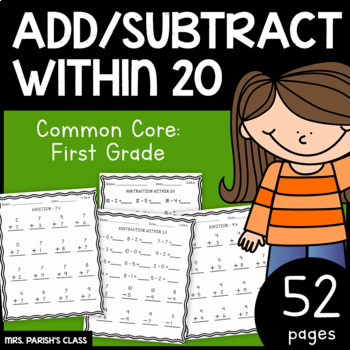52 pages!!! MATH! FIRST GRADE - ADD and SUBTRACT WITHIN 20
Mrs Parish's Class
260 Followers
Grade Levels
K - 4th, Homeschool
Subjects
Resource Type
Standards
CCSS1.OA.C.6
Formats Included
- PDF
Pages
54 pages
Mrs Parish's Class
260 Followers
What educators are saying
I love this product! I teach self-contained Autistic Support for grades 2-5. This resource was helpful for differentiation to meet all my students. Highly recommended!
This resource has been so helpful in supporting students with practicing adding and subtracting within 20. I love that there are a variety of pages to choose from and the format is inviting & has enough room for students to show their work if needed.
Also included in
- This math bundle is a great resource!!The bundle includes all of these:ADD AND SUBTRACT WITHIN 20DOUBLE DIGIT ADDITION AND SUBTRACTIONWORD PROBLEMSCOUNT TO 120COMPARING NUMBERS TO 50TIME TO THE HOUR AND HALF HOURGRAPHINGPrice $14.40Original Price $16.00Save $1.60
Description
52 PAGES OF ADDITION AND SUBTRACTION PROBLEMS.
MATH BUNDLE 50% OFF!
Included in this product: addition only
Separate review pages for addition 0 - 10's. (horizontal and vertical review)
addition to 10 (horizontal and vertical review)
doubles addition
addition to 20 (horizontal and vertical review)
Included in this bundle: subtraction only
Separate review pages for subtraction 0 - 10's.
subtraction within 10 (horizontal and vertical review)
subtraction within 20 (horizontal and vertical review)
Total Pages
54 pages
Answer Key
N/A
Teaching Duration
N/A
Report this resource to TPT
Reported resources will be reviewed by our team. Report this resource to let us know if this resource violates TPT’s content guidelines.
Standards
to see state-specific standards (only available in the US).
CCSS1.OA.C.6
Add and subtract within 20, demonstrating fluency for addition and subtraction within 10. Use strategies such as counting on; making ten (e.g., 8 + 6 = 8 + 2 + 4 = 10 + 4 = 14); decomposing a number leading to a ten (e.g., 13 - 4 = 13 - 3 - 1 = 10 - 1 = 9); using the relationship between addition and subtraction (e.g., knowing that 8 + 4 = 12, one knows 12 - 8 = 4); and creating equivalent but easier or known sums (e.g., adding 6 + 7 by creating the known equivalent 6 + 6 + 1 = 12 + 1 = 13).






